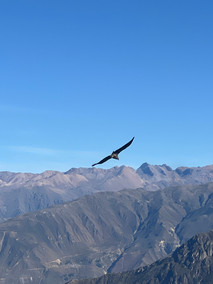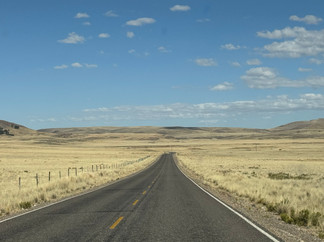The natural and cultural wonders of Colca Canyon
- bstclair579
- Jul 14, 2024
- 3 min read
One of the most amazing sights on our travels has been sitting on the edge of Colca Canyon and watching the magnificent Andean condors soaring below us with barely a flap of their wings.
The Andean condor is the largest flying bird in the world. It weighs up to 33 lbs and has a wingspan of more than 10 ft. (The wandering albatros has a larger wingspan of 11-12 ft.) It is an incredible flyer. Because they are so heavy, they have a difficult time getting off the ground (particularly after they have gorged themselves on some dead animal). But once aloft, they rarely flap their wings. A recent study attached recording equipment to some condors in Argentina that recorded each wingbeat over more than 250 hours of flight time. They found that the birds flapped their wings only 1% of the time. One bird flew for more than five hours and more than 100 miles. They tend to be in areas with consistent winds. The Mirador Cruz del Condor in Colca Canyon is one such place. You can be pretty much assured to see condors there in the morning after sunrise when the warming air creates consistent breezes around the corner of the canyon. It was so special watching these huge birds soaring back and forth past us without flapping their wings. Spectacular.
Another wonderful aspect of Colca Canyon is the strong indigenous culture of the towns and countryside. We spent the first night parked at the plaza in the town of Yanque. When we arrived, a nice woman approached us and asked us if we needed directions or information. She told us about the town and that it was okay to sleep in the plaza. She also mentioned that she had a restaurant nearby, which we decided to check out. It was delicious. I had lomo saltado de alpaca and Sheri had roasted chicken. We sat and talked with her and her husband for a while and enjoyed some great music videos on their television (including from Playing for Change). Turns out he is quite a fan of blues music. They were so nice and she gave us her phone number in case we needed anything. After dinner, we headed to the plaza to park for the night. As soon as we arrived, a large group of dancers and a band came around the corner and paraded around the square. It was part of a festival of the bulls that weekend. Very special. Yanque is also known for the traditional "wititi" dance, recognized by UNESCO as an Intangible Cultural Heritage of Humanity. It is performed for tourists every morning by girls and women, young and old. The dance starts at about 7 am and lasts for about an hour, accompanied by a market of traditional crafts. We woke up to the start of the dance and enjoyed watching.
The next evening after visiting the Mirador Cruz del Condor and some other towns, we headed up into the mountains to explore. We visited a geyser that was a fountain of hot water continually shooting out of the ground. On the way, we helped a Peruvian couple that got stuck trying to get up the road. Afterwards we found a beautifully lonely place to camp above the canyon with a nice view of the active volcano Sabancaya. As the volcano spewed steam and ash, I couldn't help wondering if it wasn't a bit dangerous and that it might spew a larger eruption with a pyroclastic flow.
On the way to our next destinations, we enjoyed seeing the landscapes of the high plateaus of the Andes, including many herds of alpacas and vicuñas. At one point we drove up to an elevation of over 5,000 m (16,500 ft), a personal record for Sheri and Hank.













































































































so you had alpaca for dinner, how did it taste? Your photos reminded me of Ecuador. We went to see the majestic condors take flight over huge cliffs. So majestic. And those gigantic volcanos, Good thing this one stayed quiet when you were there!